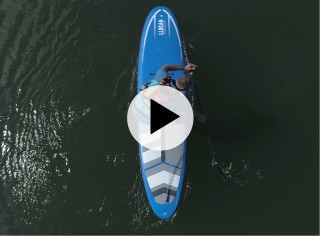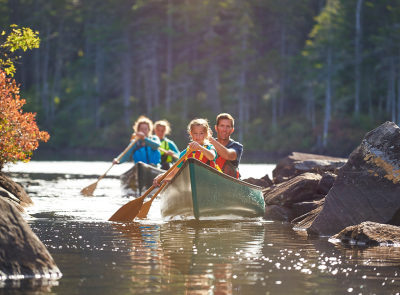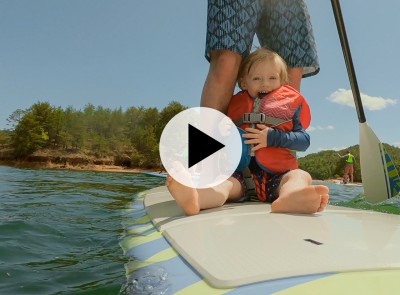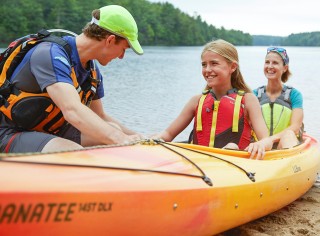5 Tips for Paddling Safely
Having fun while paddling is important, but so is staying safe. Check out these safety tips from our paddling expert before you get on the water.
1. Wear a PFD (Personal Flotation Device)
There are lots of choices when it comes to choosing a PFD or life jacket and it’s not always easy to know which is best for you. When you’re out paddling, whether you’re on a kayak, stand up paddleboard or canoe, we recommend a type 3 PFD vest. Not only are they adjustable and more comfortable to wear, they’re inherently buoyant so when you have them fitted properly, they’re the best choice for the water. They also come in men’s and women’s styles to ensure the right anatomical fit for both.
In addition to vests, there are also life jackets with a lower profile. These are smaller and more compact with bigger openings on the sides for more comfort when moving around. Low profile PFDs are perfect for kayaking, stand up paddle boarding or any on-the-water activity where you need more mobility.
When you’re stand up paddling, another option is a waist belt life jacket. Keep in mind that when using those, it has to be worn at all times. It’s the law.
When putting your PFD on, make sure all belts and buckles are connected and all zippers (if your life jacket has them) are zipped. Finally, make sure you adjust all straps to ensure a snug and secure fit. When a life vest is properly fitted and adjusted it won’t come up off your body at all.
And remember, the most important thing to know about PFDs is they only work when you have them on.
2. Bring Rescue Equipment
Sometimes when you’re out kayaking, people can capsize. So, here’s some great rescue equipment to help you, or someone else, get back into the boat.
Paddle Float – with this tool, the blade of the paddle goes into the float and you blow it up through a tube to create a kick stand to help you get back in the boat.
Bilge Pump/Sponge – Once back in the boat, the bilge pump will help empty the water out of the boat. And a sponge is always handy to absorb excess water.
Rescue Sling – this is a piece of one-inch tubular webbing with a float, so you won’t lose it in the water. What this does is create a stirrup to help people get back into a kayak or stand up paddle board.
Tow Belt – If you’re out paddling with a bunch of people and someone gets tired, injured or the weather changes, this is a great tool to help someone get back to shore.
Flares – Only to be used in an emergency, flares are a great piece of safety equipment to have on hand when you need to show visual distress and require help. Not all flares are waterproof so putting them in a container, like a Nalgene bottle, is an easy way to keep them safe and dry.
3. Always Know Where You Are
Knowing where you are and how to get home is an extremely important part of paddling safety. Here are some navigation tools to help you stay the course.
Chart or Map – A chart is basically a map that covers water when you’re out on the ocean and a map is something you would use more inland. You’ll need a compass of some sort to use these tools.
Deck Mounted Compass – This is a compass that goes on top of the deck of your kayak or board. It’s a great tool to have when paddling on the ocean.
GPS (Global Positioning System) – If charts and compasses sound too complicated, another option for finding your way around the water is a GPS. While a GPS may be easier to use than a chart or map, it’s still very important to know how to use it properly before heading out on the water. And when you do choose one, make sure it has all the features you need (and want). GPSs come in a variety of sizes and styles, from handheld devices to watches.
4. Keep a First Aid Kit Handy
It’s always better to be prepared. That’s why a first aid kit is one of the most essential items to bring on any paddling trip. It’s great for the unexpected, from cuts and scrapes to bumps and bruises. We’ve got some excellent first aid kits available with everything you’ll need. Or grab some first aid supplies and a waterproof bag and make your own.
5. Don't Forget the Extras
It’s always great to have some extra essential items on hand like water, food and sunscreen. Bringing extra clothes or an additional layer is also a good idea for when the weather changes, the wind picks up or you’re wet and need to get warm and dry. After all, the more comfortable you are while paddling, the more fun you’ll have.
Now that you have these tips for paddling safely on the water, we hope to see you out there soon.
Related Stories








